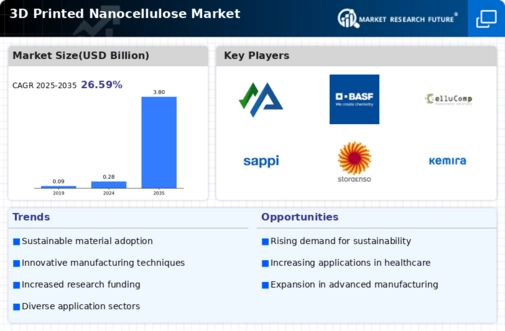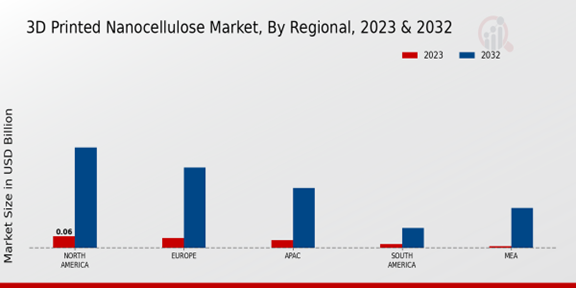Market Growth Projections
The Global 3D Printed Nanocellulose Market Industry is projected to experience substantial growth over the next decade. With an anticipated market size of 0.28 USD Billion in 2024, it is expected to reach 3.8 USD Billion by 2035. This growth trajectory indicates a remarkable CAGR of 26.75% from 2025 to 2035. Such projections highlight the increasing adoption of nanocellulose in various applications, driven by advancements in technology and rising demand for sustainable materials. The market's expansion is likely to be influenced by ongoing research, government support, and the emergence of new applications across multiple sectors.
Advancements in 3D Printing Technology
Technological advancements in 3D printing are propelling the Global 3D Printed Nanocellulose Market Industry forward. Innovations in printing techniques, such as improved resolution and speed, enable the production of complex structures with nanocellulose. These advancements facilitate the material's application in diverse fields, including biomedical engineering and aerospace. The ability to create customized products tailored to specific needs enhances the appeal of nanocellulose in 3D printing. As the technology continues to evolve, it is expected to attract more investments and research, further driving market growth and expanding the range of applications for nanocellulose.
Rising Demand for Sustainable Materials
The Global 3D Printed Nanocellulose Market Industry is witnessing an increasing demand for sustainable materials as environmental concerns gain prominence. Nanocellulose, derived from renewable sources, offers an eco-friendly alternative to traditional plastics. This shift is driven by industries seeking to reduce their carbon footprint and enhance sustainability. As a result, the market is projected to grow from 0.28 USD Billion in 2024 to 3.8 USD Billion by 2035, reflecting a robust CAGR of 26.75% from 2025 to 2035. This growth indicates a significant transition towards greener manufacturing processes across various sectors, including packaging, automotive, and construction.
Growing Applications in Biomedical Sector
The Global 3D Printed Nanocellulose Market Industry is experiencing a surge in applications within the biomedical sector. Nanocellulose's biocompatibility and biodegradability make it an ideal candidate for medical devices, tissue engineering, and drug delivery systems. As healthcare continues to prioritize innovative solutions, the demand for 3D printed nanocellulose products is expected to rise. This trend is supported by ongoing research and development efforts aimed at enhancing the material's properties for medical applications. Consequently, the market is likely to benefit from increased funding and collaboration between research institutions and healthcare companies, further solidifying its position in the biomedical field.
Supportive Government Policies and Funding
Government policies and funding initiatives are playing a crucial role in the growth of the Global 3D Printed Nanocellulose Market Industry. Many governments are recognizing the potential of nanotechnology and are investing in research and development to foster innovation. Grants and subsidies aimed at promoting sustainable materials and advanced manufacturing techniques are becoming more prevalent. These supportive measures not only encourage private sector investment but also stimulate academic research, leading to breakthroughs in nanocellulose applications. As governments continue to prioritize sustainability and technological advancement, the market is likely to experience accelerated growth and increased competitiveness.
Emerging Market Opportunities in Developing Regions
The Global 3D Printed Nanocellulose Market Industry is poised to benefit from emerging market opportunities in developing regions. As these regions industrialize, there is a growing interest in adopting advanced manufacturing technologies, including 3D printing. The potential for cost-effective production and the ability to create customized solutions are appealing to manufacturers in these areas. Furthermore, the increasing awareness of sustainability is driving the demand for eco-friendly materials like nanocellulose. As infrastructure develops and investment in technology rises, the market is expected to expand significantly in these regions, contributing to the overall growth of the global industry.






















